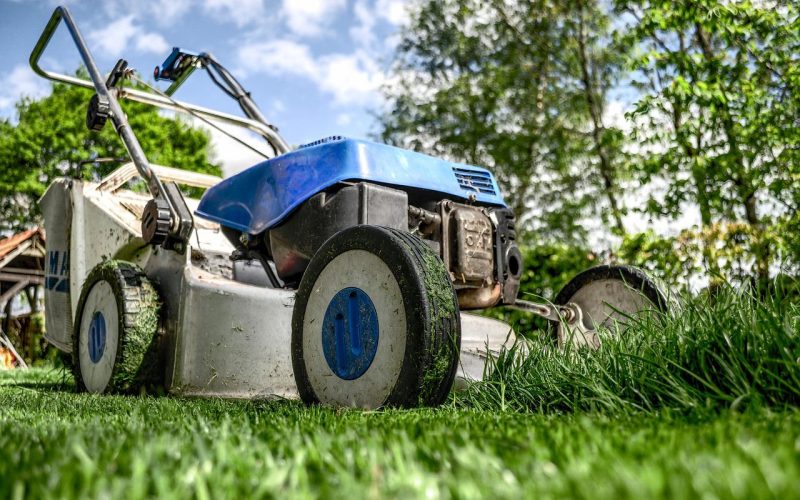We list all the different types of lawnmowers available to you and describe their subtle differences.
Wishful thinking won’t help you realize your goal of having a lush, well-kept lawn like that one neighbor; a dependable type of lawn mower will!
A lawn mower appropriate for the size of your yard, the type of grass, and your budget can significantly benefit your lawn.
Nevertheless, whether you’re new to the lawn game or a seasoned veteran, there are so many types of lawnmowers available that it might be overwhelming even to attempt to choose the right one.
Here are the different types of lawnmowers that you can use.
1. Ride-On Mowers
Ride-on mowers can be very convenient when you have a large lawn or are lazy on a Sunday morning and don’t feel like standing for an hour.
As the name implies, ride-on mowers allow you to sit inside them and operate them like a car, making mowing much more fun and effective!
Despite their high cost, walk-along mowers are typically preferred over ride-on mowers.
2. Push Mowers
You are the primary source of power for a push mower. Push mowers have various engines, but all the power goes into cutting the grass as you push the mower to the desired location.
This mower is a good option if you enjoy the added workout of pushing a lawn mower around your yard.
Mower weights can range from 60 to 70 pounds, though lighter and heavier models are available.
Mower weights also vary. The weight is listed in the product specifications when buying a lawn mower.
3. Reel Mowers
Using reel lawn mowers to maintain your lawn is a sustainable practice.
They don’t need electricity, gas, or oil because they don’t have an engine.
They are silent. Like a push mower, the exercise is good for you.
Furthermore, your lawn may benefit most from a reel mower. These mowers cut grass like scissors rather than ripping it, leaving your lawn looking lush and well-kept.
However, doing this might necessitate mowing twice weekly. Cylinder mowers and the alternative, rotary-blade mowers, are contrasted by Lawnsmith.
4. Lawn Tractors
Lawn tractors are a particular kind of ride-on mower. They typically have front-mounted engines and deck widths between 42 and 54 inches.
These are the ride-on mowers most frequently purchased and used.
Because of their expansive decks, they are an excellent option for large lawns.
Lawn tractors are available in various shapes, sizes, and features, including cylinder counts, horsepower, gear transmission, etc.
While they’re great for large lawns, a decent lawn mower will cost you between $1,000 and $3,000; additionally, they’re not very maneuverable, difficult to turn quickly, and difficult to tackle those tight edges and spots.
5. Hover Mowers
These lawnmowers virtually defy gravity by riding on an air cushion.
Hover mowers are ideal for use in tight spaces where other mowers cannot reach or maneuver around because they can move side to side in addition to the standard forward and backward movements.
Mowers with wheels and rotary blades operate and function differently than hover mowers.
6. Robotic Lawn Mowers
Unbelievably, the small device in the image is a lawnmower. Have you ever admired the robotic vacuums that keep your floors clean while you watch? There is an outdoor cousin to these robotic vacuums. In contrast, you unwind in a hammock and sip lemonade.
Robotic lawnmowers operate only in the space you define by setting up a boundary wire. You can set up these mowers to cut your grass whenever you want.
Furthermore, if you want, you can run it at night while it’s quiet.
Some users find the installation and programming processes complicated.
However, as soon as the initial setup is finished and done correctly, you can relax and wait for your robotic lawn mower to cut the grass as you direct. This is one of the different types of lawnmowers.
7. Riding Lawn Mowers
Steering wheels are a standard feature on riding mowers to increase comfort and maneuverability.
They don’t cut grass as precisely as walk-behind mowers or even zero-turn riding mowers, but they keep your yard from looking overgrown.
42-inch dual hydrostatic zero-turn lawn mower with a movable seat and mulching capabilities.
Furthermore, a particular kind of riding lawnmower is a zero-turn model. This mower is designed to work effectively and precisely around obstacles and turns.
With these, you can trim grass that is growing next to landscaping.
Standard riding lawnmowers frequently have trouble getting close to obstacles, leaving a patch of uncut grass close to buildings and other landscaping.
Technically speaking, a riding mower can also be a lawn tractor.
8. Zero-Turn Mowers
Another type of ride-on mower, zero-turn mowers, is controlled by lap bars in the front seat. These bars drive two hydrostatic transmissions at the back wheels.
This means, in simpler terms for some of us, that these mowers, thanks to their distinctive designs, can provide unmatched maneuverability!
Furthermore, these mowers, known as the “Ferraris of the Lawn Mowing World,” quickly handle sharp turns, pivots, tight edges, and spots while cutting more precisely and closely to obstacles than other ride-on mowers.
Furthermore, they produce a better lawn finish. Because of their maneuverability, they are a fantastic option for lawns with irregular shapes.
The fastest and most maneuverable lawnmowers available are zero-turn models. This is one of the different types of lawnmowers.
9. Electric Powered Mowers
Mowers powered by electricity come in two varieties: corded and cordless.
Corded mowers require an electrical outlet, whereas cordless mowers can be moved around freely like other walk-behind mowers.
Electric mowers have advantages and disadvantages, just like any other type of mower.
They are practical because they require less upkeep, are quieter, and weigh less than their gas-powered counterparts.
However, they can be a pain to use if they are corded.
The battery of a corded electric mower doesn’t deplete while you’re mowing, and it doesn’t need to be charged while you’re not using it.
Since cordless mowers lose power while cutting, you may shorten your mowing time relative to the length of your grass.
While some electric lawnmowers have batteries, others do not. Before purchasing, check to see if you need a separate battery.
10. Gas-Powered Lawn Mowers
Gas-powered lawnmowers don’t require charging, and their range is unrestricted by a cord.
They need routine engine maintenance to maintain excellent performance and lengthen their lifespan.
While gas lawnmowers are noisier than other types, they are also more powerful. They can almost effortlessly cut through thick, long grass.
Additionally, they reduce the time you spend mowing. This might simplify mowing your lawn if you don’t mind that they are heavier than other mowers. This is one of the different types of lawnmowers.
11. Rear-Engine Riding Mowers
Rear-engine riding mowers are a good option for moderately sized lawns—the ones that are too big for walk-along mowers but not small enough for lawn tractors. They are also part of the ride-on-mowers family (as the name implies).
These single-cylinder engines and continuously variable transmission lawnmowers have their engines at the back, underneath the driver’s seat, with the deck directly in front of the driver.
Furthermore, Rear-engine riding mowers typically have deck sizes between 30 and 33 inches, making them ideal for lawns smaller than 2.5 acres in size because they can withstand the endurance required by such lawns
12. Flail Mowers
Flail mowers are intended for the brush you are certain doesn’t contain thick branches and trunks.
Although there are walk-behind options, many of these attach to the back of a tractor.
They are known as “flail” mowers partly because they don’t scatter things they cannot cut.
They deflect them, continuing to move. This enables you to cut through a tall, opaque brush safely.








